New novel by Roger Vaughan
Published on May 1st, 2023
Coming Again, the lively sequel to Roger Vaughan’s novel, Coming About, set in the round the world race, has just been released. The crafty Isha has escaped. Andy’s real father, Grady, who Andy found after 25 long years, turns out to be a shady character. The sailing is intense. So is the story. It’s on Amazon, soft cover or eBook (links above). Enjoy this excerpt:
Crouse was steering when All American struck something. It wasn’t a hard hit. Having been drifting through a windless hole for more than six hours, a very rare condition considering their position, the boat had barely been making headway. The crew was a week into the leg they were sailing in the South Pacific Ocean. They were halfway between Auckland, New Zealand, and Cape Horn, a distance of 4,500 miles, about as far from land in any direction as possible on planet Earth, and afloat on the surface of roughly 5,000 feet of water. Talk about isolation. Colliding with anything in that location was cause for alarm. It wasn’t a whale, always a threat. Hitting a whale would have produced a much bigger shock. More of a dull thud. Whatever they’d hit had a definite metallic resonance.
Andy awoke from a sound sleep with a start. The keel! He leaped up and grabbed a flashlight. It was around 2:00 a.m. and very dark. The slight contact had been enough to rouse the entire crew. To everyone’s horror and amazement, they found themselves peering over the side at a container. Like a growler (a hunk of an iceberg about the size of a pickup truck), only one corner of the container was showing above water. The rest of the forty-foot-long steel box that weighed nearly three tons empty was partially visible beneath the surface. It was an ugly sight, lurking like a monster, menacing in its unlikely lair; a random disaster waiting to happen to some unsuspecting craft. Mostly full of water in addition to whatever was being shipped in it — there was no guessing what it actually weighed. All American’s keel had gently encountered the dread object, and the boat had nearly come to a stop as it slowly nudged its way along the container’s side. Andy took a breath. The only damage to the keel would be a few scratches.
“I’ll never complain again about not having any wind,” Larry Kolegeri said quietly, staring dumbfounded at the thing that was wallowing obscenely in the calm waters.
“Imagine hitting that at twenty knots,” Damaris said.
Eric was shooting video. “Or ten. Even five! Our good luck,” he said, “all the numbers are on the side we can see. We’ll soon know who this thing belongs to. They lose nearly a thousand of these things overboard every year, can you imagine?”
“Our good luck,” Jan Sargent said, shaking his head. “I’ll say. Put out a bulletin with a waypoint and the time,” Sargent said to Eric. “Let everybody know it’s in the area.”
*
The restart in Auckland had been uneventful other than the visit from a fast, forty-foot cruiser that had chased All American down an hour later. The boat had come in very close astern, much to Sargent’s concern, until he saw the bikini-clad woman pressed against the cruiser’s bow pulpit waving a present and shouting for Teddy Bosworth. Amid heavy commentary from his mates, Teddy went to the stern and accepted the gift without mishap. The cruiser quickly backed away with cries of “Come back, Teddy . . . I’ll miss you” drifting across the water, cries the crew would take up unmercifully for the rest of the race.
The crew was heading for a bout with the Southern Ocean, the pièce de résistance of The Race. It would be the boys’ second engagement with the planet’s most challenging place to sail, let alone race: a thousand-mile-wide swath of two-mile-deep ocean encircling the globe between sixty degrees south and Antarctica. The fact that weather there is unimpeded by any continental land mass, not even a decent-sized island, makes these waters whimsically, and dangerously, active. Gale-force winds, storms, very large waves, even blizzards romp centrifugally around the Southern Ocean. The crew had sustained a good Southern Ocean whomping in a previous leg that had finished in Fremantle. That spinnaker knockdown, with the boat lying on its side for nearly a minute before the sail had been cut free, was one of those frightening sailing moments they would never forget. They had girded themselves for another invasion of this no-man’s-sea.
Ask any of them about their primary motivation for coming on The Race and the answer would likely have been the same: sailing the Southern Ocean. Just as mountaineers have their wish lists of ultimate places to climb — Annapurna, K2 — ocean racers check off major events like Sydney Hobart, Fastnet, and Transpac. But racing in the Southern Ocean stands atop the list. If you are just slightly out of your mind, you can tackle the Southern Ocean double-handed on the Barcelona World Race, which is nonstop. If one is truly beyond hope, he or she can enter the single-handed Vendée Globe round-the-world race, also nonstop, most of which is spent in the Southern Ocean. A much more reasonable way to experience the Southern Ocean is to be part of a full, seasoned crew on The Race, with stops every one to six thousand miles to have hot showers, experience a new port, socialize, and eat some fried chicken. And it’s more fun to celebrate the screaming reaches and share the inevitable breakdowns, the often brutal weather, and various other crises that probably will occur with a trusted and capable team of similarly overly cranked sailors. For years afterward one can celebrate — reconfirm! — the adventure over a pint with another gonzo bloke who was there. But even with strong mates on either side, a barroom brawl is still a barroom brawl. Heading into the Southern Ocean will always increase one’s heart rate.
All American’s brush with the container was the subject of conversation for several days. It was such a frightening near miss. What could have been — the boat holed and sinking quickly beneath their feet, serious injuries, the mast coming down, and many days in a life raft if the thing even inflated — chilled their dreams. Once they have put their lives in Mother Nature’s hands, ocean sailors are superstitious creatures. Collectively the crew kept wondering why they had been spared. It came up on Andy’s watch one night. All American had finally escaped the little local doldrum and was heading south at a reasonable pace. It was quiet on deck, cold but relatively comfortable. Stu Samuels had put it best. “Mother Nature simply isn’t that friendly,” he said, “or that empathetic with us humans who are savaging her planet with carbon dioxide and floating containers. What in hell got into her to slow us down so we didn’t get ripped apart by that thing?”
“Drugs,” Damaris said. “She must have been smokin’ weed again.”
“Naw,” Caskie said. “It’s Jan. She loves Jan.”
“I think it was Sam,” Andy said. “Sam must have paid her a visit. He had a way with women.”
“Seriously, you have to ask why,” Stu persisted. “You do. We’re not a bunch of choirboys. We’re freaking sailors. We live selfish lives driven by the desire to be at sea. We’re like those Joseph Conrad sailors who get in trouble when they’re ashore for more than a couple days. Unless we’re jibing the chute or trimming the backstay we’re basically irresponsible wayfarers who drink too much and shirk normal responsibilities. Why’d she save our sorry asses?”
“I stole a car once,” Kolegeri said. “I was drunk. Needed a ride. Hit a pole. Walked away.”
“I purposely made a bad call,” Andy said. “Port starboard situation, out to get my pretend father, said we could make it when I knew we couldn’t. At the last second I told him to tack.”
“And he did,” Stu said.
“Yeah, but he might not have. Would have wrecked boats, killed people. Unforgivable. Stupid.”
“And that is why we’re here,” Stu said.
For a while they listened to the water burbling past the hull, looked at the stars, and silently contemplated their own missteps.
“I got married,” Damaris said. “Knew it was a bad idea. Did it anyway. Disaster.”
The thought of Damaris being married made Stu laugh. “’Least you didn’t have any kids.”
“There was one time both my wife and my girlfriend were pregnant,” Damaris said.
“Don’t let Mother know that!” Stu said.
“Come on, guys,” Sargent said. “Everybody’s got skeletons. It’s all random. The good, the bad, and the ugly all get cooked in the same pot. I just hope we haven’t used up our luck.”
*
They hadn’t. Mother Nature blew away the calm with a more expected, freshening westerly that would peak at around twenty-five knots with higher gusts, driving All American toward Cape Horn with a vengeance. They had come out of Auckland and headed southeast, the smart strategy for picking up westerly storm tracks, or low-pressure systems that would push them in the right direction. They had run into the calm spot along the way.
Once hooked into the Low, the sailing was both exhilarating and exhausting. Damaris seemed to have put them in just the right place where they had encountered a strong Low and were able to stay in it. They were on the south side of the Southern Ocean, but not dangerously so. Go too far south and there would be ice to contend with. To keep the more irrationally ambitious crews from choosing that route in the interest of finding even more wind, the race committee had set a southern boundary. The crew had seen a couple of large bergs several miles off to starboard, but nothing closer. A bow watch for growlers was on constant, one-hour shifts, and nothing had been spotted. But they all knew sustaining speeds of around twenty knots day after day had to be putting a nasty strain on boat and gear.
The water never stopped flying, the boat’s many voices never stopped shouting, laughing, hollering, and screaming as it planed down fifteen-to-twenty-foot waves, slammed into rogue seas, and kept trying to take scary knockdowns. The work never stopped. The helmsmen held everyone’s well-being in their hands. After an hour at the helm they were toast, such was the effort to keep All American upright and in the groove, both safe and fast.
Rigging was routinely checked. Places where chafe could occur were frequently examined. Jib sheets had been changed several times. Many days of being constantly redlined had a certain numbing effect on the crew. One can imagine the thrill of hitting twenty-plus knots on a sixty-footer for a few hours. After days of it, the routine of being constantly soaked and cold, struggling to stay upright on the deck, trying to get any sleep as the boat surged and slammed, and the ordeal of pumping one’s personal bilge in the midst of all that, became torturous.
The racket the boat made as it tore its way over and through the seas was extraordinary. Down below might have been a high-volume echo chamber for a sound-effects disc of car crashes and construction sites. It took a while to comprehend that a sudden violent sound did not necessarily mean something had broken or been damaged. But there was always the chance that it did.
Every sailor on board harbored unspoken anxiety about the boat’s ability to handle such extreme, sustained conditions. Crewmen off watch collapsed below on sail bags in their foulies. If they were needed on deck there would be no time to dress. “My uncle,” Dave Zimmer said to Sargent as he spooned another glop of freeze-dried mystery “food” into his mouth during a meal grabbed while sitting on wet sail bags, “was a fighter pilot. Nam. He could fall asleep anywhere if he had ten minutes because that’s how uncertain it was between missions. That horn would go off, and they’d scramble. As a kid I never quite understood. Now I get it.”
Sargent related how a doctor had done a sleep study with a solo round-the-world sailor. “His autopilot went out on him and he had to steer for almost thirty hours in big following seas. He told the doc he went into some stage of sleep for three to four seconds when he was planing down the face of a wave, and would wake up when he was sailing up the back of the next one. The doc said that had probably saved him.”
Fifty miles from Cape Horn, the Low that had carried them ran out of gas. The afterguard (Damaris, Jan Sargent, and Andy) had been slowly aiming the boat further north, by all accounts the most favorable approach to Cape Horn. When the sun had risen on their fourteenth day out of Auckland, there it was, the stubby profile of Cape Horn. Rising less than a thousand feet, Cape Horn is an inconsequential peak among South America’s many giants. What it lacks in physical stature, it makes up for in designating a world-famous land’s end. Some of the roughest seas in the world can be found there, along with the gales that help create them. Drake Passage, between Cape Horn and the Antarctic Peninsula, is where the Southern Ocean is at its narrowest. As it approaches the Cape, the ocean bottom rises from ten thousand feet to a few hundred feet in just a few miles, a steep profile that creates mountainous seas. But not this day.
“More good luck,” Sargent said quietly, training his binoculars on Cape Horn. The sun was out, the sky was clear. It was blowing eight to ten knots. The boat was quiet, plodding along at the speed of the wind. The crew had organized the boat. It was drying out below. Everyone was up, not wanting to miss this magic moment.
“This is Cape Horn? Where’s all the heroics, man?” It was Larry Kolegeri, obviously unimpressed.
“I’ll take it,” Damaris said. “You wanna see muscle? Watch the videos. There are plenty. The best one was shot by a guy named Irving Johnson in nineteen thirty. Famous sailor and storyteller. He had one of the first movie cameras, eight millimeter. Amazing dude. Climbed to the topm’st of the four-hundred-foot schooner he was on and shot the waves, graybacks he called them, decks awash. They were in a hundred-fifty-mile-per-hour storm. Wrote a book about it.”
“This is like going to watch the Jets play and discovering Joe Namath is out sick, if you know what I mean.”
“We could leave you here in the RIB if you want the experience,” Sargent said. “I’m told there’s a gale here every three or four days.”
“All right,” Larry said, “so I’ll watch the videos.”
An hour later, with Cape Horn abeam off to port, Sargent produced a bottle of vodka that was passed around. Some of it was dutifully poured into the sea as a gesture of respect for Neptune, one of Mother Nature’s heavies.
Six hours later, sailing north up the coast of Argentina, they got hammered. They’d opted to sail inside the Falkland Islands, which lie about four hundred miles offshore, in hopes of picking up a more southerly slant to the wind. That had not worked out. The wind had stayed west, smack on the beam, and honking, with gusts over thirty. The main was reefed, and still the end of the boom was dragging in the water in the gusts. Stu was driving, and sailing deeper than he wanted to take the strain off the gear. The seas were also beam-on, and large. Finding a fast path through the waves was a challenge for the helmsman, a matter of coming off a bit to surf down the face of one wave and not getting smacked when he came up over the top of the next one. If he nailed it three waves out of every five he was racking up hall-of-fame points.
The mains’l ripped apart that night, fourteen hours after rounding Cape Horn. It took all hands nearly a half hour to wrestle the sail down, organize it on deck, and raise the storm trysail, which would at least provide some headway. “I hate to say it,” Larry Kolegeri said to Damaris as they were fighting with the sail, struggling to pull the wet luff down out of the mast groove a few inches at a time, “it’s crazy, but having this happen is a relief. I knew the Old Lady was screwing with us. It could have been the mast. I’ll take this.”
“Should have given her the whole bottle,” Damaris said.
The brutal work began. Dick Hooper, who had replaced RD, supervised the operation. He handed out sail needles, palms, and waxed thread. The main had ripped from the outer edge toward the mast about halfway up. The tear had increased to fifteen feet or more by the time the crew had gotten the sail down. The idea was for the men on deck to bring the torn edges together with patch material, tacking it together every four inches or so. The crew worked in pairs, one passing the needle through the sail, the other retrieving it on the other side and passing it back through. Then it was hauled below to Hooper, who would finish the job by wrestling it through the sewing machine. Those who weren’t sewing sat on the sail to keep it from sliding into the sea, because while the reduction in boat speed had made the motion less violent, the spray less constant, the weather had not changed. Thanks to cold fingers trying to manipulate the slippery sail needles on an unsteady platform, the patches were soon liberally spotted with blood. The darkness didn’t help. It was an exhausting, uncomfortable process.
The repair to the main took six hours, six hours when All American’s speed was reduced to eight knots; six hours when they knew the other boats were doing twice that, or more. The wind abated a bit as dawn broke, but getting the main back up was still a struggle. At the helm, Andy would bear off to get headway, then bring the boat close to the wind, at which point there would be lots of feeding of the luff rope into the mast groove and cranking of the halyard. After half a dozen repetitions, the sail was up, and trimmed.
“Looks pretty good,” Dave Zimmer said, examining the patchwork.
“Looks to me like another case of rum,” Sargent said. He was right. On the twenty-second day out of Auckland, when they had a good view of the finish line off Punta del Este, Uruguay, there was Ram Bunctious at the dock.
“I’m just glad to be here,” Sargent said. “Glad I’m able to buy him a case of rum.”


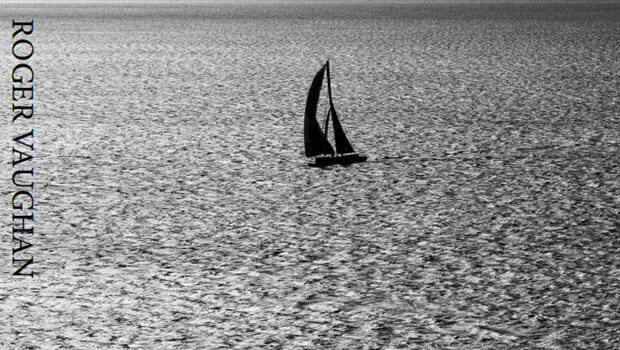

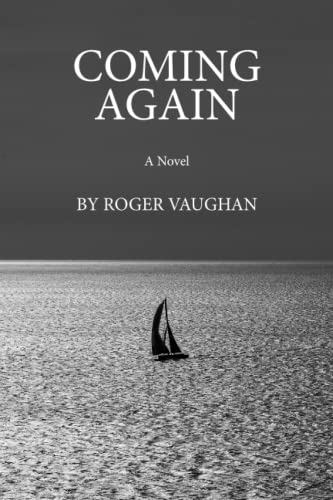

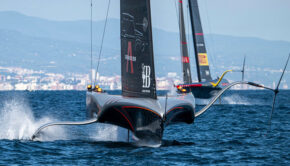
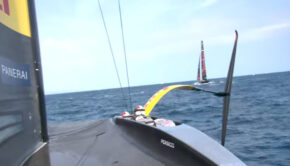
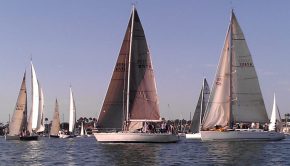
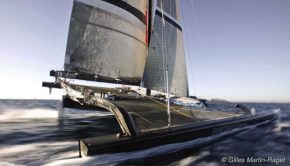
 We’ll keep your information safe.
We’ll keep your information safe.